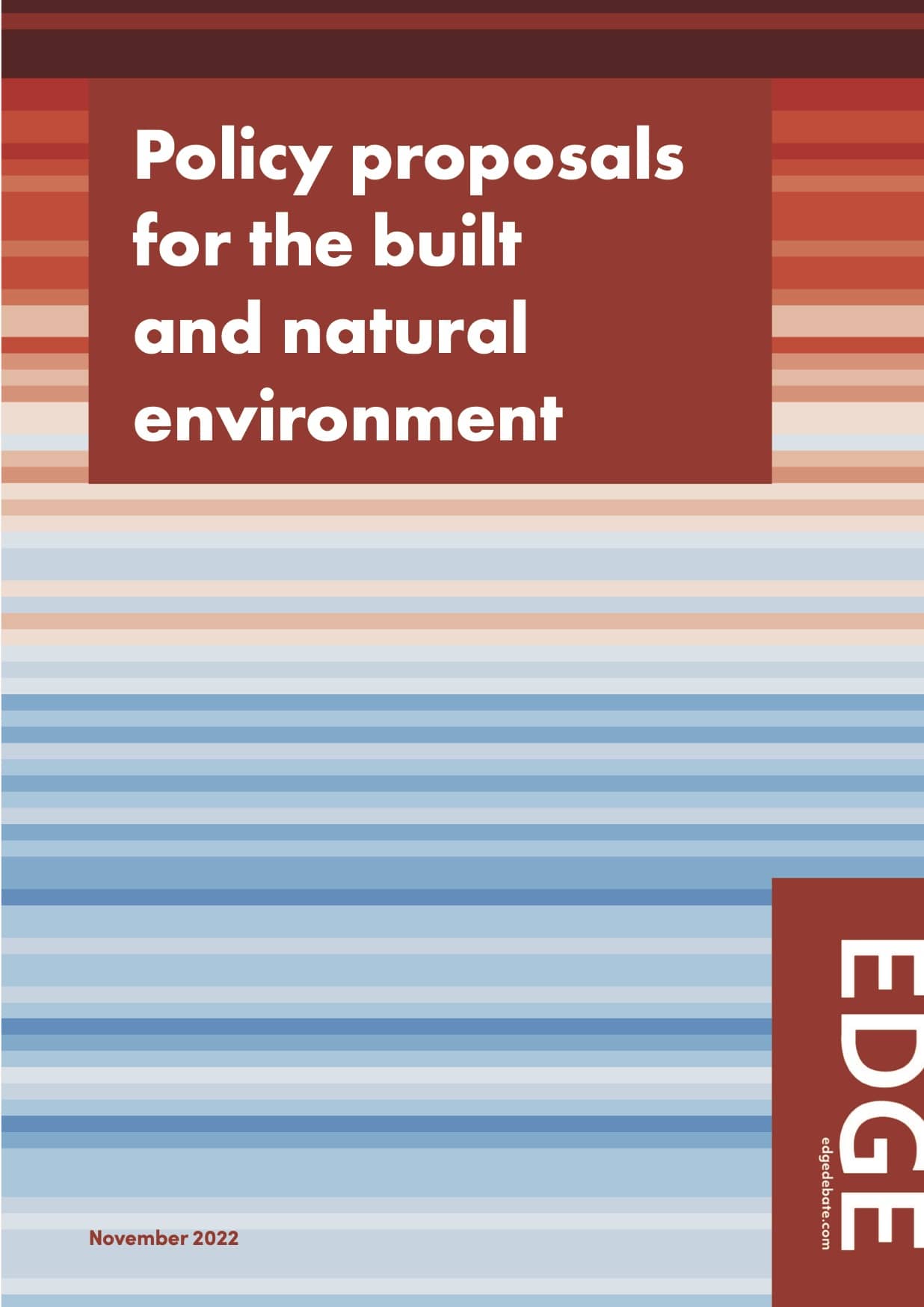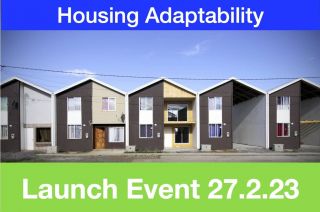
www.buildingsandcities.org/insights/news/policy-proposals-built-environment.html
Policy Proposals for the Built and Natural Environment
A wide, coordinated set of policy proposals for built environment is launched for tackling global warming and biodiversity.
The UK built and natural environment think tank, the Edge, has drawn on the widespread expertise of its members to produce a concise set of interconnected policy recommendations aimed at enabling the design, construction and property industries to deliver on their obligations in the face of the twin climate change and biodiversity emergencies. The policy proposals are an urgent Call to Action to prevent on-going environmental and social harm.
The Proposals

Organised under 8 headings, ranging from the broad to the tightly focused, each section is typically the responsibility of a different government department or part of the industry, the proposals describe how the built and natural environment sector can and must change. To succeed nearly all of the proposals need to be acted on together and with the greatest urgency. They cannot and should not be cherry picked or delayed.
The intended audience is busy, and often distracted, policy and decision makers and, in consequence, the document is written to be as accessible and straightforward to grasp as possible with each proposal usually just a single sentence. This means that the very necessary detail, deliberation, research and references required to back them up are missing and the Edge intends to publish a follow up document, with fuller information and detailed arguments for the propositions, later in 2023.
The focus is on the UK industry and government, both local and national, but the great majority of the proposals are applicable globally.
The 8 thematic sections are as follows:
1. An economy that supports the
environment
There
is an urgent need to restructure the economy to one that that actively supports
the environment, including a reform of tax structures to support good behaviour
and penalise bad. A tax on carbon and other pollutants produced by products and
services should replace Value Added Tax at a revenue neutral rate. Incentives are
also required to reward carbon reduction, biodiversity net-gain, minimising the
use of virgin resource and enabling circular economy businesses and projects.
Utility providers should be reinvented as public interest organisations charged
with driving forward the net zero carbon agenda.
2. Planning for the benefit of
society as a whole
Planning
and planning policy must be re-focused on achieving social value with
measurable and monitored objectives applied to achieving a range of core social,
economic and environmental goals. Planning policy must be required to take the
needs of future generations into consideration and should flow seamlessly into
other aspects of design and construction including building regulations, health
and safety practice and facilities management to achieve the 'golden thread'
that connects decision-making on projects throughout their life cycle.
3. Using our limited land
intelligently and productively
Using our limited land and natural resources well is critical for delivering on
social and environmental objective, whether good housing and employment or
clean air and access to open space. A coherent land use strategy that balances
conflicting requirements for the British Isles is long overdue and should help
drive a wide range of public goods including equitable and fair access, healthy
and safe environments, greater biodiversity and food, energy and energy
security.
4. Delivering essential
infrastructure and transport
The
provision of essential infrastructure and transport is required to support a
future equitable and low carbon society and economy, fairly balancing
availability and distribution of public provision, but it needs to be
configured to encourage maximum resource and energy responsibility and
accountability.
5. Building climate and
biodiversity skills and understanding
Without
clear understanding, motivation and relevant skills across all sectors of
society it will be impossible to cope adequately with the climate and
biodiversity emergencies. All stages of education from primary to tertiary must
help deliver the skills that will enable individuals and communities to
flourish in the decades ahead.
6. Measuring, declaring and
eradicating carbon emissions
The
construction and property management sectors need to routinely measure and
declare carbon emissions, en route to eliminating them. Building owners should
be required to plan for and manage an ever-shrinking carbon budget
7. Creating a resilient built and
natural environment
Climate
change and biodiversity loss are already with us and measures must be taken to
cope with and moderate their impact if cities and urban areas are to remain
liveable. These include the widespread
application of nature-based solutions and ensuring the resilience of essential
systems.
8. Design and construction acting
in the public interest
Finally, the
construction and property industries need to take responsibility for
eliminating their large (40%+) proportion of national carbon emissions. Building
passports that provide essential data and contractual performance guarantees should
become the norm.
Next steps
The document is freely available at https://edgedebate.com/s/theEdge_PolicyProposals_1122.pdf. Hard copies are also available on request via the Edge's website.
The
Edge welcomes discussion and debate on these topics and will be arranging
public sessions in the months ahead to do just that. Alternative propositions
are very welcome.
Latest Peer-Reviewed Journal Content
A living lab approach to co-designing climate adaptation strategies
M K Barati & S Bankaru-Swamy
Mediation roles and ecologies within resilience-focused urban living labs
N Antaki, D Petrescu, M Schalk, E Brandao, D Calciu & V Marin
Negotiating expertise in Nepal’s post-earthquake disaster reconstruction
K Rankin, M Suji, B Pandey, J Baniya, D V Hirslund, B Limbu, N Rawal & S Shneiderman
Designing for pro-environmental behaviour change: the aspiration–reality gap
J Simpson & J Uttley
Lifetimes of demolished buildings in US and European cities
J Berglund-Brown, I Dobie, J Hewitt, C De Wolf & J Ochsendorf
Expanding the framework of urban living labs using grassroots methods
T Ahmed, I Delsante & L Migliavacca
Youth engagement in urban living labs: tools, methods and pedagogies
N Charalambous, C Panayi, C Mady, T Augustinčić & D Berc
Co-creating urban transformation: a stakeholder analysis for Germany’s heat transition
P Heger, C Bieber, M Hendawy & A Shooshtari
Placemaking living lab: creating resilient social and spatial infrastructures
M Dodd, N Madabhushi & R Lees
Church pipe organs: historical tuning records as indoor environmental evidence
B Bingley, A Knight & Y Xing
A framework for 1.5°C-aligned GHG budgets in architecture
G Betti, I Spaar, D Bachmann, A Jerosch-Herold, E Kühner, R Yang, K Avhad & S Sinning
Net zero retrofit of the building stock [editorial]
D Godoy-Shimizu & P Steadman
Co-learning in living labs: nurturing civic agency and resilience
A Belfield
The importance of multi-roles and code-switching in living labs
H Noller & A Tarik
Researchers’ shifting roles in living labs for knowledge co-production
C-C Dobre & G Faldi
Increasing civic resilience in urban living labs: city authorities’ roles
E Alatalo, M Laine & M Kyrönviita
Co-curation as civic practice in community engagement
Z Li, M Sunikka-Blank, R Purohit & F Samuel
Preserving buildings: emission reductions from circular economy strategies in Austria
N Alaux, V Kulmer, J Vogel & A Passer
Urban living labs: relationality between institutions and local circularity
P Palo, M Adelfio, J Lundin & E Brandão
Living labs: epistemic modelling, temporariness and land value
J Clossick, T Khonsari & U Steven
Co-creating interventions to prevent mosquito-borne disease transmission in hospitals
O Sloan Wood, E Lupenza, D M Agnello, J B Knudsen, M Msellem, K L Schiøler & F Saleh
Circularity at the neighbourhood scale: co-creative living lab lessons
J Honsa, A Versele, T Van de Kerckhove & C Piccardo
Positive energy districts and energy communities: how living labs create value
E Malakhatka, O Shafqat, A Sandoff & L Thuvander
Built environment governance and professionalism: the end of laissez-faire (again)
S Foxell
Co-creating justice in housing energy transitions through energy living labs
D Ricci, C Leiwakabessy, S van Wieringen, P de Koning & T Konstantinou
HVAC characterisation of existing Canadian buildings for decarbonisation retrofit identification
J Adebisi & J J McArthur
Simulation and the building performance gap [editorial]
M Donn
Developing criteria for effective building-sector commitments in nationally determined contributions
P Graham, K McFarlane & M Taheri
Join Our Community

The most important part of any journal is our people – readers, authors, reviewers, editorial board members and editors. You are cordially invited to join our community by joining our mailing list. We send out occasional emails about the journal – calls for papers, special issues, events and more.
We will not share your email with third parties. Read more



Latest Commentaries
COP30 Report
Matti Kuittinen (Aalto University) reflects on his experience of attending the 2025 UN Conference of the Parties in Belém, Brazil. The roadmaps and commitments failed to deliver the objectives of the 2025 Paris Agreement. However, 2 countries - Japan and Senegal - announced they are creating roadmaps to decarbonise their buildings. An international group of government ministers put housing on the agenda - specifying the need for reduced carbon and energy use along with affordability, quality and climate resilience.
Building-Related Research: New Context, New Challenges
Raymond J. Cole (University of British Columbia) reflects on the key challenges raised in the 34 commissioned essays for Buildings & Cities 5th anniversary. Not only are key research issues identified, but the consequences of changing contexts for conducting research and tailoring its influence on society are highlighted as key areas of action.